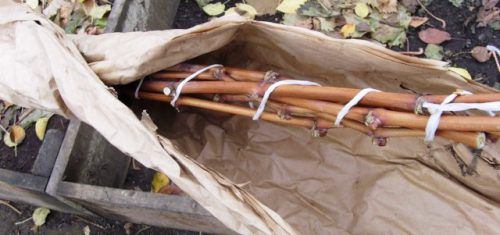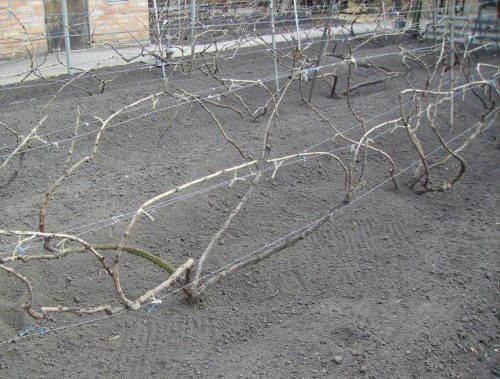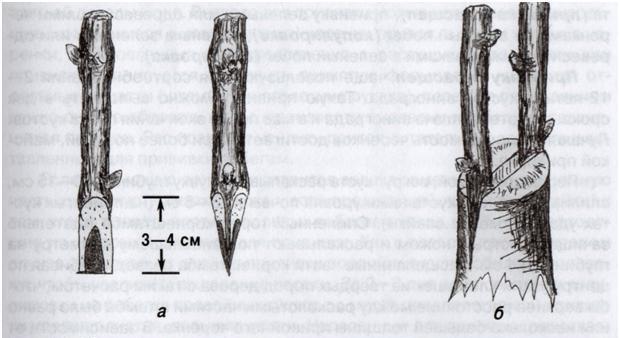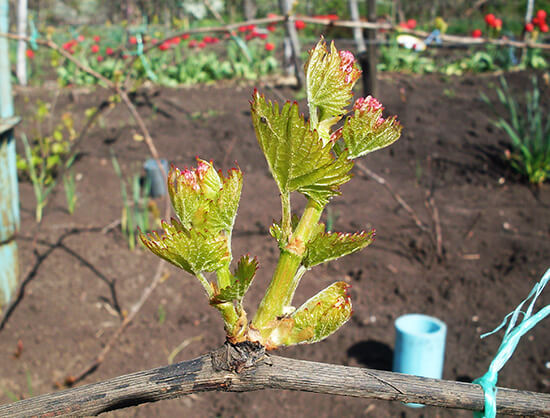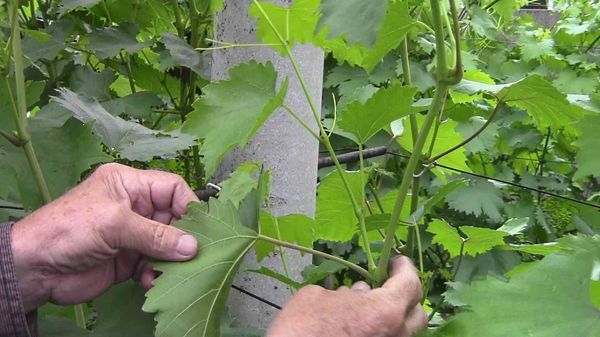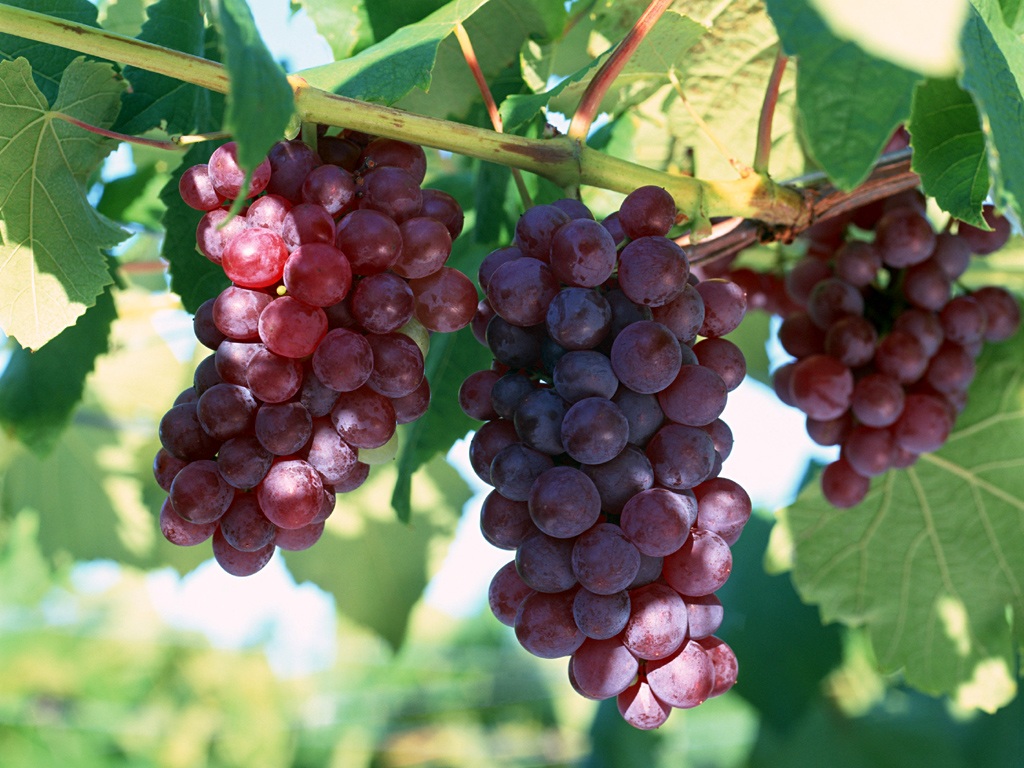Grapes are a heat-loving plant. Mild southern winters, without strong and prolonged frosts, make it possible to grow it there in a non-sheltered way. What should those who live in Central Russia, Siberia or the Urals do and want to grow this wonderful crop on their site? You can plant grapes and get good harvests even in harsh climatic conditions. To do this, you should choose varieties with greater frost resistance, and be sure to cover the vines for the winter. Then the question arises: when to remove the shelter and how to properly care for the grapes in the spring?
Content
Working with grapes after winter
It is necessary to remove the shelter from the grapes only when the average daily temperature does not drop below +10 degrees, and the weather forecast is favorable. Under these conditions, the soil warms up and the plants wake up. During the winter, a special microclimate was formed under the shelter, so it would be wrong to take off the “fur coat” right away. This is done gradually, over several days, accustoming the plant to other conditions. If your vines were wrapped with covering material and covered with sawdust or leaves, then they are raked off a little and the insulation is turned halfway. Then, after a day or two, they open more. In favorable weather, the shelter is finally removed after another two or three days and what was used to insulate the vines (sawdust, leaves) is removed.
If you have grapes on your site planted in trenches, the walls of which are reinforced with slate or brick, and are covered with wooden shields for the winter, then they are slightly shifted, and after a few days they are removed completely. In regions where the spring is lingering, several holes are made in the shelter of the grapes for ventilation. Then, if the weather permits, it is gradually removed. If it is not removed in time, then there is a risk of developing fungal diseases, since moist soil and the accumulation of condensate favor this.
The shelter is finally removed only when the threat of frost has passed and the weather is warm. This period is different in different regions. In the south, it may be the end of March - early April, and in the northern regions - in May.
First treatment and garter
After the cover is completely cleaned, carefully examine the vines. The underdog shoots have a dark, moist to the touch surface. There may be traces of mold. Such shoots are removed immediately if sap flow has not yet begun. Then the grapes must be treated with a solution of copper sulfate (300 grams per 10 liters of water). It is best to do this while the vines are tied in bunches. The ground around the bushes is also carefully sprayed with the same solution. The next day after processing, the vines are fixed on the trellis. The soil is loosened and mulched with sawdust or straw, which reduces the evaporation of moisture.
The spring garter takes place in two steps. The first time after removing the shelter, it is also called "dry garter", the second - when the green shoots grow, it may be the middle or the end of May.It all depends on the weather conditions in the region.
Usually, before sheltering the grapes in the fall, the bushes are pruned, leaving the required number of vines. If the wintering was successful, and in the spring you did not see rotten or dried shoots, then all that remains is to fix the branches on the trellis. When pruning is required, carefully examine the bush. If the sap flow has already begun, you will see moisture on the autumn cuts. In this case, it is better to postpone pruning until normal leaves appear, otherwise the vine will begin to "cry", and this has a bad effect on the growth of shoots.
When a mature bush is removed from a mature or dead branch, it does not cause significant damage to it. Other vines remain. But what if a young plant planted last summer is damaged? It hibernated, having 2–3 shoots, and they had to be removed in the spring. Do not despair. You can try to "revive" such a bush by awakening dormant buds located under the soil surface. To do this, dig a little in the soil to the beginning of the roots. We cover this place with a piece of roofing material (approximately 50x50 cm). In the middle of it we make a hole about 10 cm in diameter. We cover the excavation with roofing material and sprinkle its edges with earth. Pour warm water into the hole, with the addition of a growth stimulator (according to the instructions). Depending on the weather conditions, after about 1-3 weeks, the bud will wake up and sprout.
Top dressing and frost protection
For the first time in the spring, fertilizing is applied before bud break, in the "green cone" stage. You can do this with mullein solution. A bucket of manure and two buckets of water are mixed and left for a week. Then 1 liter of infusion is diluted in 10 liters of water and brought under the bush, and once again fed before flowering. Mullein is sometimes replaced with bird droppings (1 part to 4 parts of water to insist for a week). Then the resulting mixture is diluted with water (1:10) and the plants are watered, at the rate of 1 liter of solution per bush, before bud break and before flowering. You can, as a top dressing, take 20 grams of superphosphate, 10 grams of ammonium nitrate and 5 grams of potassium salt per 10 liters of water. Per bush. Or take complex mineral fertilizers (according to the instructions). Introduce before bud break and before flowering. Top dressing contains nitrogen, and this gives an impetus to the active growth of shoots and the formation of brushes.
In the spring, in regions with a cold climate, the probability of return frosts is very high. Green buds may die. In severe frosts, the roots of young plants suffer. It is not entirely true not to remove the shelter until the heat is established. There is a high likelihood of developing fungal infections under it, since the humid environment contributes to this. Better if you replace the winter shelter with breathable material (spunboard or similar).
It happens that a sharp cooling (to zero and below) can occur when the vines are already fixed on the trellis and there are already green shoots and small tassels are visible. A sharp temperature drop can ruin your crop in just a few hours. It is no longer possible to remove vines from the trellises, you can damage them. There is a way out in this position. You can make a shelter by covering the bushes with the same spanboard on all sides, at a height of 50-60 cm from the ground. At the bottom, press down the edges of the material with boards or bricks. In this position, the tops of the vines may suffer, but the bulk of the shoots and, most importantly, the brushes, will be saved. Gardeners are resourceful people. They come up with various ways to save heat-loving grapes. Here is one such method, which has been tested more than once.
To make the grapes warmer, every spring I pour a thin layer of river sand under the roots. On the sides I put bottles of water made of dark plastic, which accumulate heat during the day and give it to plants at night.
Another effective way to protect grapes is to sprinkle it with iron vitriol (according to the instructions), with the threat of a cold snap.Such treatment is carried out to delay the onset of vegetation and bud break, and as a preventive measure against fungal diseases.
Spring watering
The time of the first spring watering is determined based on the condition of the soil. If there was enough precipitation in winter, and the melt water deeply moistened the earth, then you should not rush to watering. Excess moisture can lead to root rot. Watering time can be determined by the condition of the soil at a depth of 40-50 cm. If a lump of earth from this level does not crumble after being squeezed in your hand, then there is enough moisture. When there was little rainfall in winter and spring, the first watering is carried out even before the buds open. It can be combined with top dressing. Watering with cold water will slow down the start of the growing season. If there is a threat of cold snap, then you can use this so that the kidneys do not die. Conversely, warm water speeds up the growing season. Watered for the second time three weeks before flowering... Again, if necessary, the soil is dry and there is no rainfall. Watering just before or during flowering can cause shedding of flowers. Water for the third time, if necessary, in mid or late May... The amount of water per adult plant depends on the variety and size of the bush, and ranges from 30 to 80 liters per watering. Water is poured into grooves 20 cm deep, at a distance of 50-60 cm from the trunk, allowing it to be completely absorbed. Pay attention to the ends of the green shoots. If they are curved, then the plant has enough moisture, and it develops well.
Vaccinations
Anyone who grows grapes tries to have different varieties. When the size of the land plot does not allow planting a large number of plants, such a well-known method as grafting comes to the rescue. The properties of the bush allow it to grow several varieties with different ripening periods.
The most favorable time for spring grafting is when the buds are swollen and the vine is "crying". The sap of the plant will additionally moisturize and disinfect the junction. Copulation, cleft and butt are the most common methods of grafting. Even a novice gardener can handle them. You just need to have a sharp garden knife, string and tape for wrapping around the junction. When grafting cuttings are prepared in advance, they are stored in a cool dark place in a damp cloth.
Plants up to three years of age are suitable for grafting. A few days before the operation, the bush is watered.
Copulation performed on one-year-old shoots of the same thickness, preferably 7–8 mm. The graft, the graft that is grafted, should have 2-3 well-developed buds (length 10-12 cm). The bark is free from damage and stains. The lower oblique cut is made at a distance of 5 cm from the kidney. The top of the cutting is cut horizontally. The distance to the bud is 2 cm. The rootstock and the scion are carefully combined and tightly wrapped with tape.
Cleft grafting allows you to use a thicker branch as a rootstock. This makes it possible to use 2–3 cuttings of different varieties.
This grafting option can be used on a separate branch, or if the bush is completely cut down. Make a split at least four centimeters deep. The stalk is cut obliquely on both sides. We leave about one centimeter to the lower kidney. We insert the stalk into the cleft and tightly wrap it with tape (from bottom to top). The upper part of the cut can be covered with bark and covered with clay, or the canvas can be wrapped with foil (if the cut diameter is not very large).
Grafting in the butt it is used in the event that it is difficult to do it in another way. Wedges are cut in the form of triangles on the scion and rootstock. Try not to damage the lower kidney and the bark under it. Align the cutouts tightly and wrap them tightly with tape.
There is one more way of vaccination - back to back. But it is quite time consuming and is used in breeding work.
Many people think that grafting during the "crying" period of the vine weakens the plant and is best done when the "tears" have stopped. How many people, so many opinions. Grafting at a later time, when the leaves have already appeared, it is then that the grapes stop "crying", it does not always take root well. On the other hand, if everything went well for you, then that's great. "Not recommended" does not mean "not allowed." Everything is in your hands, and only those who do nothing fail.
Green operations
In order for the plants not to thicken and bring a good harvest, they carry out the removal of twins, pinching and chasing. What it is? When the buds swell and open, you can see that two, sometimes three shoots can appear nearby. They are called doubles or tees. Leaving them this way will lead to thickening. The result will be the spread of fungal diseases. Excess shoots are carefully broken off, leaving one of the strongest.
Chasing is the cutting of the upper part of the green vine, which makes it possible to channel nutrients into the formation of the crop and ripening of the shoots. Chasing is carried out in several stages, as the shoots of the current year grow back. The start of trimming will differ from region to region. In the south, it may be the end of May, and in Siberia - the beginning of July.
In order to properly shape the bush, after removing the cover, the vines are fixed horizontally on the trellis. Growing green shoots are fixed vertically. Their number should correspond to the capabilities of a particular plant. A large number of shoots will thicken the planting and contribute to the appearance of diseases. The number of brushes will become excessive for normal ripening, and the quality of the berries will deteriorate.
The shoot apex is removed approximately above the 20th leaf (2–2.1 m). This provokes the rapid growth of stepchildren.
Their uncontrolled growth can turn your vineyard into impassable thickets very quickly. Stealing carried out regularly in 7-10 days. Up to the 18th leaf, they are removed completely by cutting out with pruners, or gently breaking off at the base. The upper stepsons are shortened, leaving 1–2 sheets. When new shoots appear, they are pruned according to the same principle. Leave 1–2 top sheets. A "cap" is formed, which provides nutrition to the ripening berries. In the second half of August, minting is carried out for the last time. In this case, the “cap” of the stepsons is cut off. On a fruit-bearing plant, this is done at the twentieth, in young ones - later by 12-14 days. Chasing improves the ripening of berries and vines. Shoots tolerate wintering better and are less damaged.
Girly (wild) grape care in spring
Maiden grapes are very drought-resistant and absolutely not whimsical plant. He has no diseases and pests. It grows rapidly, up to two meters per season, and is incredibly decorative. In landscape design, girlish grapes are widely used to decorate the walls of buildings, fences, gazebos and awnings. But even the best plants have their drawbacks. In the spring, it begins to be covered with foliage later than other plants, and the bare shoots are not very decorative. In addition, girlish grapes are quite aggressive plants and tend to capture territory. If you do not limit its space, it grows quickly. Shoots that are not fixed on a support quickly take root, this feature of the plant is also taken into account in landscape design, using it as a ground cover plant.
Spring care for this plant is not very difficult. With the onset of warm weather, the grapes are examined and dried, broken, diseased and excess shoots are removed. Since the plant is drought-resistant, it must be watered if there was little rainfall and the soil is dry. Maiden grapes tolerate excess moisture worse than lack of moisture. This must be taken into account when caring for him.After watering, the soil is loosened and mulched.
To maintain decorativeness, top dressing is applied twice a season, in spring and autumn. It is better to use complex mineral fertilizers (according to the instructions). They are dissolved in water or watered before fertilizing.
Features of spring work in the regions
The order of spring work in the vineyard is the same everywhere: removal of shelter, garter, processing, watering, fertilizing. But each region has unique climatic characteristics, and there are nuances in caring for this plant.
In outskirts of Moscow open grapes, as elsewhere, with the onset of a steady plus on the thermometer. The probability of return frosts and cold snaps at night in this region is high, so do not rush to completely remove the shelter. For several days, you can cover the grapes at night, especially if the weather forecast is not happy. Kidney freezing is a very common problem here. In this case, there is only one way out - cropping. Leave more buds on young shoots, but also in moderation. A heavily overloaded vine will not be able to produce a good harvest and mature for winter. If the whole bush is badly damaged, then it is removed completely. Such a plant can be saved by awakening dormant buds located at the heel roots (more on this in paragraph 1.1 of our article).
After the final removal of the shelter, the grapes are fed with complex fertilizer (according to the instructions) once a week until the berries ripen, and mulched with rotted foliage. In the Moscow region, the soils are poor in magnesium. Its deficiency affects the condition of the plant and the quality ripening of shoots and berries. In the spring, magnesium is introduced twice, with an interval of two weeks, in liquid form (250 grams of magnesium sulfate per 10 liters of water). The dosage is indicated for one adult bush. Water if necessary. But before the blossoming of the inflorescences, no later than three weeks, it is needed. The next watering is 10-14 days after flowering.
Pruning is preferable in the fall, or very early in the spring, before sap flow begins, if the plants have not overwintered well. You shouldn't pull with a garter either. From damp earth and covering material, fungal infections are possible. If the spring is cold and rainy, it is better to try to provide shelter for the vines already attached to the trellis. This will provide air circulation and reduce the risk of infection.
In the spring, treat the planting with Bordeaux mixture or any fungicide on the shoots and the ground around them. Spraying repeat after 7-10 days, then before and after flowering. If last summer there were fungal diseases on the plants, then treatments can be carried out additionally after the rains.
In the Volga region, Bashkiria, Tatarstan open grapes in late April or early May. Spray with a solution of 800 grams of urea and 200 grams of copper or 250 grams of ferrous sulfate per 10 liters of water or a 3% solution of Bordeaux liquid. To protect against spring frosts, many install portable greenhouses. They put arcs and cover with a film. In such a greenhouse, the grapes feel great and quickly begin growing. In the daytime, the shelter is raised for ventilation, and closed at night. By the time the frosts stop (late May-early June), the vines already have small green shoots. The shelter is removed gradually, within 3-5 days, accustoming the plant to the external temperature.
Pruning is carried out before the start of sap flow. The vine is cut at a distance of 2-3 cm from the bud. So many shoots are left so as not to overload the bush. It depends on the variety and age of the plant. Watering is carried out before bud break. If necessary 2-3 times. Watering is resumed before flowering for three weeks, and 10-14 days after it.
In the Urals grapes are grown mainly in the southern regions. It is best to use zoned, winter-hardy varieties of early ripening. The region has severe winters and cool summers and a lot of rain. In such conditions, dark grapes, even early varieties, rarely fully ripen.He needs more sun and warmth. Therefore, mostly white and pink grapes are grown in the Urals. Getting a harvest in the Urals is a very time consuming task. It is possible to cultivate grapes here only using a covering method.
The first watering is carried out before bud break. Do it again if necessary. Two weeks before, and 10-14 days after flowering, plantings are also watered. The soil must be loosened and mulched. Top dressing is required. The first after removing the shelter. Superphosphate, potassium and nitrogen fertilizers are introduced (according to the instructions). The second feeding is carried out before flowering, and consists of organic matter with the addition of potassium and phosphates. Nitrogen fertilizers are applied in a minimal amount, and only once. Large doses of this microelement provoke a rapid growth of the green mass, and the shoots do not have time to fully mature in a season. In addition, large amounts of nitrogen cause fungal infections.
The main pruning is done in the fall, and in the spring - only when necessary. Before the start of sap flow, the frozen and damaged shoots are removed and tied up. The vines and the soil around the bushes are treated with 3% Bordeaux liquid or any fungicide. If in the previous season the plants were sick, then spraying is carried out, with an interval of 7-10 days, before flowering. After him - as needed.
In the Kuban climatic conditions make it possible to grow grapes without covering. Young plantings can sometimes freeze slightly, but not because of severe frosts. This is due to sharp temperature fluctuations from plus to minus. Therefore, it is better to cover such plants. Mature shrubs tolerate local winters well enough. The heat comes early, and at the beginning of April it is already possible to tie the vines and treat them with Bordeaux liquid or fungicide. Pruning is done as early as possible. If the grapes are not covered, then the dried, broken and excess shoots are removed in March.
Before bud break, apply complex mineral fertilizers (according to the instructions), dissolving in water. Before flowering, feeding is repeated or replaced with a solution of mullein or bird droppings. Watering begins in April, once every 10 days, at which time the active growth of green shoots begins. Watering is stopped 20 days before and two weeks after flowering. Another top dressing is applied when the berries become the size of a pea. Use a mullein solution or complex fertilizers (according to the instructions), combining it with watering.
In Crimea spring planting of grapes is preferable to autumn planting. Therefore, the plants are planted in late March - early April. The climatic conditions here make it possible to grow even such an old Uzbek variety as Khusayne white (Ladies fingers) without shelter, which dies at a temperature of -10 degrees.
Here, vines are not removed from the trellises for the winter, and pruning can be carried out from the end of February. Cut out the shoots that overload the bush, dried up and sick. The vines are shortened, leaving the required number of buds. They are treated with Bordeaux liquid or copper-containing preparations. The first feeding is carried out before bud break with complex fertilizers (according to the instructions). Some people apply them late in the fall, so that with the beginning of the growing season, the plants have a full set of necessary trace elements. The second before flowering, and the third - when the ovary is the size of a pea.
Watering needs frequent and plentiful. When establishing industrial vineyards, drip irrigation is widely used here. Many gardeners here also use this method. This greatly simplifies the care of the grapes, reduces the frequency of watering. The earth dries up less. When watering in the usual way, this is done from the beginning of April once every 7-10 days. One adult bush needs 40 to 80 liters of water at a time. For the normal development of the plant, it is necessary that the soil is saturated to a depth of at least 60 cm, or even more. Two weeks before flowering, watering is stopped, and resumed 10-14 days after that.
In Ukraine and Moldova climatic conditions are also favorable for this culture. In these regions, grapes grow in every yard. Some varieties are harbored only in several northern regions of Ukraine. In late March - early April, the daytime temperature is +5 +10 degrees. This allows you to remove the shelter and start spring work. The vines are tied to a trellis and sprayed with a 3% solution of copper sulfate.
Feeding is carried out at the rate of 50 g of ammonium nitrate, 40 g of superphosphate and 30 g of potassium sulfate per adult bush. The second - before flowering, the third - with the appearance of the ovary. You can use complex fertilizers (according to the instructions) or mullein infusion.
Pruning is carried out for the first time before sap flow begins. When brushes appear, sterile shoots are removed and normalized (removed extra) brushes. This allows you to get a better harvest. Watering should be plentiful and weekly. At the time of flowering, it is stopped.
In Siberia growing grapes takes a lot of time and effort, but it's worth it. For cultivation, it is best to take early and northern varieties.
The device of a temporary greenhouse in spring makes it much easier to care for it. At a temperature of +5 degrees, it is opened and closed at night. This allows the plant to develop better and not be afraid of frost. The garter and pruning of grapes is carried out, as elsewhere, before the start of sap flow. A disease such as bacterial cancer causes a lot of trouble for gardeners. It is very common here, as there are conditions for its development: a long spring with frequent frosts. At the first signs of this disease, the affected shoots are removed. The cut sites are treated with a solution of potassium permanganate or hydrogen peroxide, then they are covered with garden varnish.
When applying fertilizers, nitrogen is used with caution, only in early spring and in a minimal amount. The first time before bud break, then before and after flowering. Fertilizers are diluted in water and applied only in liquid form. In spring, before bud break, if necessary. Then, from the moment the ovary appears and until the beginning of berry pouring, it is watered once every 7-10 days. After that, the earth is loosened and mulched.
In Belarus the cultivation of grapes is very popular. More than 200 varieties of local selection are cultivated here, including non-covering, frost-resistant and fungal varieties.
The grape shelter is removed at different times. In the south of the republic, in the central and northern regions - at the beginning, middle and end of March, respectively. It is opened gradually over several days. The vines are tied up, cut off and treated with a 3% solution of copper sulfate or Bordeaux liquid. Before flowering, especially if there were diseases last season, they are treated with a 1% solution of Bordeaux liquid, copper oxychloride or colloidal sulfur.
The first feeding is carried out before flowering. To do this, 1 liter of wood ash, 1/2 bucket of bird droppings or one bucket of mullein is poured into 50 liters of water and insisted for a week. Diluted in a ratio of 1:10 and watered 1-2 buckets per bush. The amount depends on the age of the plant. You can use complex fertilizers (according to the instructions). Two weeks after flowering, foliar feeding is carried out. One liter can of wood ash is infused in 10 liters of water for a week. After that, the plants are filtered and sprayed over the leaves. For the same purpose, use the drug Crystalon (according to the instructions). Before bud break, watered for the first time, then, in dry weather, at least once a week. Except flowering time.
Growing grapes is a fun process. In the spring - we dream about what kind of harvest will be in the fall. While enjoying the taste of this sunny berry, we forget about the difficulties that we had to overcome. And we look forward to next spring.
